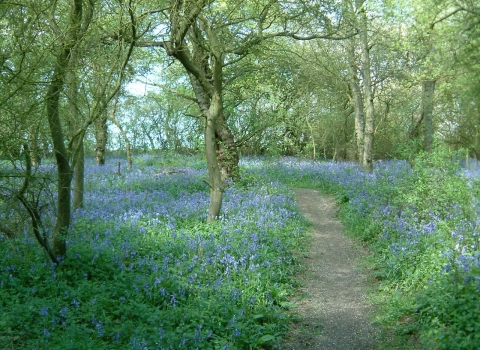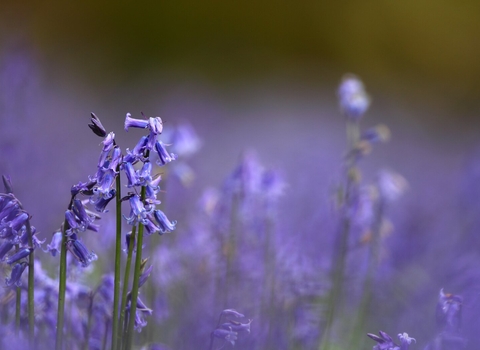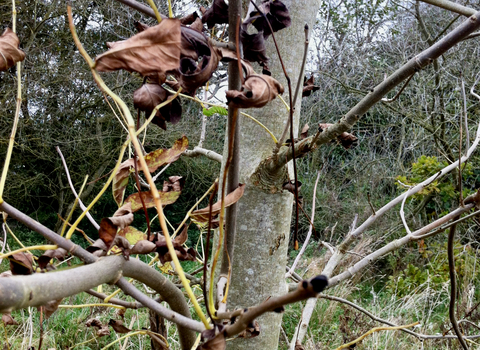Cambridgeshire has one of the lowest areas of woodland cover in the whole country which, combined with increased visitor pressure, has brought more noticeable and more prolonged negative impacts. Ancient woodlands present complex problems - waterlogged soils, standing water and deep mud all cause long term damage with continued use of paths and tracks: repeated trampling due to widening of paths causes depletion of wildflowers plus habitat loss which can take years to recover. This is the primary reason for the closure of woods for unprecedentedly longer periods of time - to prevent worse damage and give wildlife a proper chance to heal and recover, especially when vulnerable during winter and spring. This allows spring flowers and wildlife to have an undisturbed period - the frequent use of woods even by small numbers of local people can cause significant damage further exacerbated by larger numbers at peak bluebell times.
There is no easy solution to this issue as ancient woodlands can never be recreated or reproduced, trees and woods take hundreds of years to grow and develop, with special plants and animals colonising even more slowly if at all.
Clearly increasing the area of accessible woodland across Cambridgeshire that people can enjoy would help to at least relieve some of the pressure. It would be a positive step for more landowners to allow local people access to their local woods as most are currently restricted. Banning dogs, closing all or parts of woodlands when wildlife is most vulnerable are also options. These actions may be most appropriate when conditions mean that there will be known impacts and all are being tried by various different woodland owners.
However, more woodland and other habitats are needed to allow people and wildlife space to thrive. Without a significant increase of woodland in the county, and with inevitable increases in population, the situation can only be managed by the woodland owners that allow public access to try to reduce impacts and give wildlife time and space to live.
Ancient woodlands are a significant part of our national heritage and many are also designated as Sites of Special Scientific Interest - the designated woods are excellent examples of particular habitat types with unique associations of species and are protected by law. It falls to us to ensure that these special places are protected for present and future generations to enjoy and to ensure that they are kept in good condition for wildlife to prosper.
For all the reasons mentioned above it could mean that access to your local ancient woodland has been restricted for a large part of the year to give wildlife a chance to rest and repair some of the damage. This is never a decision taken lightly by the Wildlife Trust and we always seek to balance the needs of wildlife and people - we never close all of our woodlands and there will always be some woodland nature reserves accessible year round.
- Our primary concern is protecting special places for wildlife and engaging people with nature safely
- Climate change means increasingly milder, wetter winters; ash dieback has spread through woodlands; lockdown saw an increase in visitor numbers which has remained higher than usual
- These issues are outside our control and have been escalating for the past few years
Looking ahead
During the last 50 years there has been a large growth in human population in the county. Cambridgeshire has seen a 20% overall population increase in the last 20 years alone, with Cambridge and Peterborough being some of the fastest growing cities in the UK. There has also been the development of new towns such as Cambourne and significant expansions of our county towns and villages. There is also predicted to be a further 50% population increase by the 2040s.
With a current population of over 800,000 this means that if everyone visited our woodlands there would be just over 1m of accessible woodland for each person, standing room only
Unfortunately the population rises have not seen a corresponding increase in natural habitats or accessible green spaces such as new woodlands or country parks for our expanding population to enjoy. There are no nearby Areas of Outstanding Natural Beauty, National Parks or Open Access land in Cambridgeshire or that most local people can easily travel to. Some areas of green space such as the Ouse Valley and Nene Valley provide opportunities for walking but most people do not live close to the river valleys and prefer to walk close to home. There are several large scale wildlife conservation projects in Cambridgeshire looking to increase the area of wet grassland and fenland habitats but these generally do not include woodland and will not include areas of open access land.
Tackling ash dieback, despite felling swathes of affected trees, creates new opportunities for wildlife to flourish. While new trees and plants are naturally regenerating, the areas opened up will provide wildlife-rich woodland glades and rides. Butterflies, birds, fungi and woodland flowers will all thrive here, and plenty of dead wood will be left to form a vital part of the woodland ecosystem. In time our woods will find a new and healthy balance.
We must ensure that these special places are protected for present and future generations to enjoy and to ensure that they are kept in good condition for wildlife to prosper.




